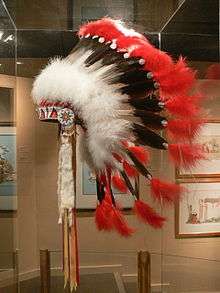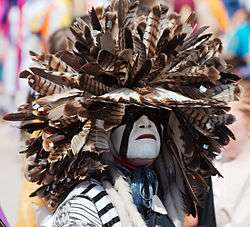War bonnet


Feathered war bonnets (also called warbonnets or headdresses) are traditionally worn by male leaders of the American Plains Indians Nations who have earned a place of great respect in their tribe. Originally they were sometimes worn into battle, but they are now primarily used for ceremonial occasions. They are seen as items of great spiritual and political importance, only to be worn by those who have earned the right and honor through formal recognition by their People.[1][2]
Ceremonial importance
.jpg)
Native American tribes consider the presentation of an eagle feather to be one of their highest marks of respect. Any honored person must have earned their feather through selfless acts of courage and honour, or been gifted them in gratitude for their work or service to their tribe. Traditional deeds that brought honour would include acts of valor in battle, but also political and diplomatic gains or acts that helped their community survive and prosper. The esteem attached to eagle feathers was so high that in many cases, such as a warrior (e.g. Dog Soldiers of the Cheyenne), only two or three honour feathers might be awarded in their whole lifetime. Historically, the warrior who was the first to touch an enemy in battle and escape unscathed received an eagle feather. When enough feathers were collected, they might be incorporated into a headdress or some other form of worn regalia. Headdresses were usually reserved exclusively for the tribe's chosen political and spiritual leaders.
Roman Nose, who was one of the most influential Cheyenne warriors of the Plain Indian Wars of the 1860s, was known for his illustrious warbonnet that was said to protect him during battle. Several instances record how while wearing his war bonnet, he rode back and forth before soldiers of the United States Army and, despite being fired upon, was left unscathed.[2]
While women have traditional regalia that can include other types of headdresses, historically women did not wear the Plains warbonnet. However, in recent years a few Indigenous women who have attained a very high level of respect in their communities have been ceremonially gifted with headdresses of the type that were formerly only worn by men.[3]
Due to their historical importance and status, many Native Americans now consider the wearing of headdresses without the express permission of tribal leaders to be an affront to their culture and traditions.[4][5] Consequently, in cases where non-Native political leaders have been symbolically allowed to wear the headdress, this has caused controversy.[3]
Legality
Plains-style bonnets are still almost always made out of eagle feathers because the eagle is considered by most tribes of the Interior Plains to be the greatest and most powerful of all birds. Under current federal legislation, the Eagle feather law enables American Indians to continue using eagle feathers in their traditional spiritual and cultural practices. The exemption is contained within the Migratory Bird Treaty Act of 1918. In the United States, only enrolled members of a federally recognized Native American tribe may legally collect or possess eagle feathers.
One traditional method of acquiring feathers for bonnets is for young eagles to have their maturest tail feathers plucked while still in the nest. This can be done three times before the feathers do not grow back. As many as thirty six feathers can be collected in this manner. If care is taken in not disturbing the nest, this method can be repeated yearly.[6]
Plains-style bonnets

Plains Indians normally use eagle feathers as the most significant part of the bonnet to represent honor and respect. Some Plains-style bonnet forms are the "horned" bonnet, "flaring" eagle feather bonnet, and the "fluttering feather" bonnet. The "horned" bonnet can consist of a buckskin skull cap, shaved bison or cow horns, and dyed horsehair with bunches of owl feathers beneath the skull cap. The "flaring" eagle feather bonnet is often made of golden eagle tail feathers connected to a buckskin or felt crown. There are slits at the base of the crown that allow the bonnet to have a "flaring" look. An unusual form of bonnet that is no longer used would be the "fluttering feather" bonnet. This can have golden eagle, hawk, and owl feathers loosely attached to a felt or buckskin cap to make it hang at the sides.[7]
Cultural appropriation
The wearing and displaying of such headdresses, and other "indigenous traditional arts and sacred objects" by those who have not earned them, especially by non-Natives as fashion or costume, is considered offensive to traditional Native peoples.[4][5][8] The controversy is part of a wider effort by Native American activists to highlight what they call the ongoing "cultural genocide" against indigenous peoples in the United States and Canada.[9] The trend of musicians and festival-goers wearing imitation warbonnets, aka "hipster headdresses" has led to criticism by Native Americans, apologies by non-Natives, and the banning of headdresses as costumes by several music festivals.[5][8][10][11]
See also
| Wikimedia Commons has media related to War bonnet. |
Notes
- Citations
- ↑ Life of George Bent: Written From His Letters, by George E. Hyde, edited by Savoie Lottinville, University of Oklahoma Press (1968), hardcover, 390 pages; trade paperback, 280 pages (March 1983), pages 207, 213, 214, 221, 239, 240, 303. ISBN 0-8061-1577-7, ISBN 978-0-8061-1577-1.
- 1 2 The Battle of Beecher Island and the Indian War of 1867–1869, by John H. Monnett, University Press of Colorado (1992), pages 46 to 48. ISBN 0-87081-347-1.
- 1 2 Behind First Nations headdresses: What you should know
- 1 2 Houska, Tara. "'I Didn't Know' Doesn't Cut It Anymore". Indian Country Today Media Network. Retrieved April 20, 2015.
On imitation Native headdresses as "the embodiment of cultural appropriation ... donning a highly sacred piece of Native culture like a fashion accessory
- 1 2 3 "But Why Can't I Wear a Hipster Headdress?". Native Appropriations – Examining Representations of Indigenous Peoples. April 27, 2010.
- ↑ Grinnell, George Bird (2008). The Cheyenne Indians: Their History and Lifeways. World Wisdom, Inc. p. 209.
- ↑ Howard, James H. (1954). "Plains Indian Feathered Bonnets". Plains Anthropologist. Maney Publishing. 1: 23–26. ISSN 0032-0447. JSTOR 25666195.
- 1 2 "ReMatriate was started earlier this year by women from the Yukon and northern B.C. in response to offensive runway fashion shows and “festival wear” appropriated from indigenous traditional arts and sacred objects and sold as commodities without permission." See "Northern-sparked 'ReMatriate' campaign takes on cultural appropriation". Northern Journal. May 4, 2015. Retrieved 2016-10-08.
- ↑ "'Still experiencing a cultural genocide'". BBC NEWS. May 13, 2016.
- ↑ "Pharrell Apologizes for Wearing Headdress on Magazine Cover". Rolling Stone. June 5, 2014. Retrieved 2015-11-09.
- ↑ "No More War Bonnets at Glastonbury Music Festival". Lakota Law Project. October 17, 2014. Retrieved 2016-10-08.
- Bibliography
- Hardin, Barry E. (2013). The Plains Warbonnet: Its Story and Construction. Book Publishing Company. ISBN 9781929572236.
- Hirschfelder, Arlene; Molin, Paulette F.; Wakim, Yvonne; Dorris, Michael A. (1999). American Indian Stereotypes in the World of Children: A Reader and Bibliography. Scarecrow Press. ISBN 9781461656302.
- Waldman, Carl (2014). Encyclopedia of Native American Tribes. Infobase Publishing. ISBN 9781438110103.